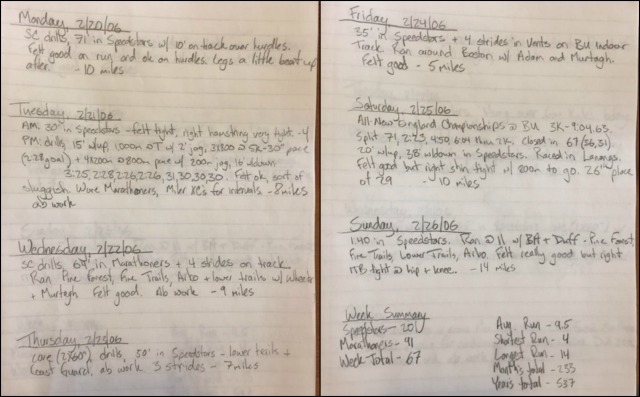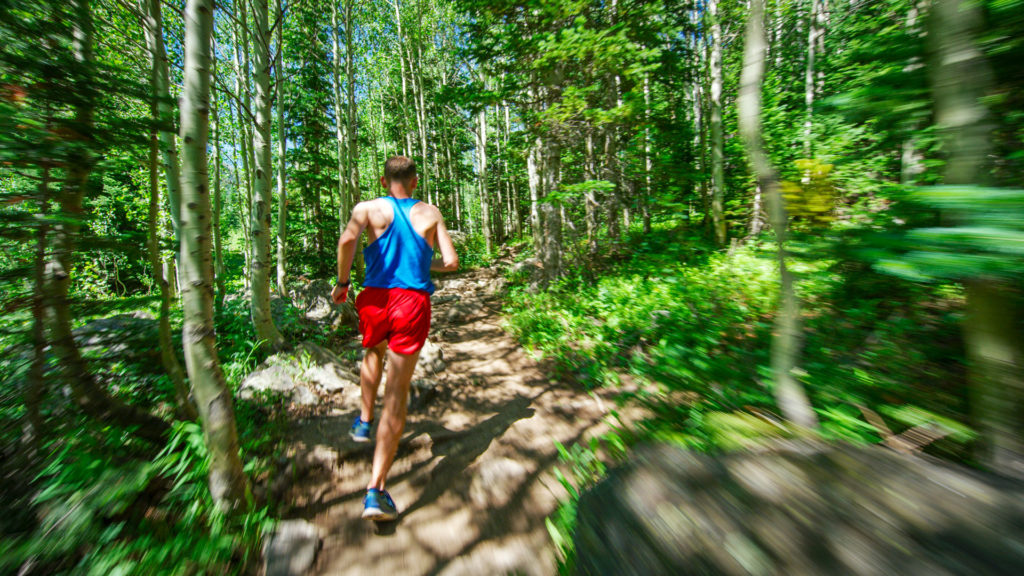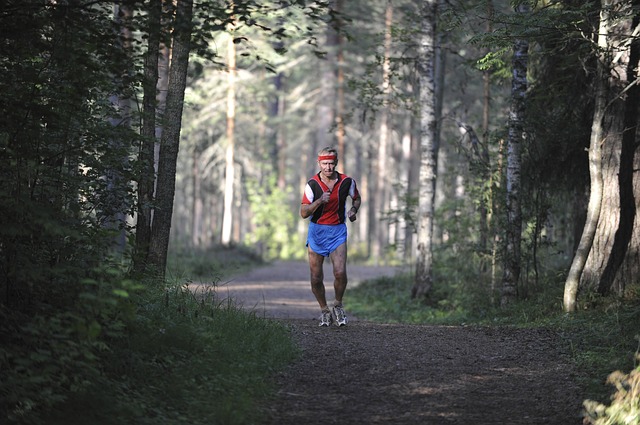Mobility might be one of the most important aspects of fitness for runners outside of endurance and strength. If you’re mobile, you’re one hell of an athlete.

Hurdling is fantastic mobility training for runners
First, a quick story.
2006 was a banner year for my running and in hindsight, a lot of that success was because I I focused on mobility training (being 22 years old certainly helped with being mobile!).
In this calendar year, I accomplished some of my best finish times:
- Mile PR of 4:33
- 800m PR of 2:05.0
- Steeplechase PR of 9:57 (and 9th place finish in New England)
- 3,000m PR of 9:04 (about 9:45 for 2-miles)
- 5,000m PR of 16:02
- 10k XC PR of 33:41
- My triathlon debut!
It was probably the best year of running in my entire life. And it all started with mobility training.
You see, in January we started indoor track. But even so, the outdoor track steeplechasers got started early on their drills. So from the very beginning of the year, I was working on hurdle mobility.
And the benefits poured into every ounce of my training. I got faster, I ran higher mileage, my workouts blew my mind.
Here’s an example:

Look at how much mobility work I was doing!
- 2 days of steeplechase (“SC”) drills
- 2 days of form drills
- 10 minutes of easy running over hurdles
- 3 days of strides
- A faster workout
- A race
All of these elements add up to a hefty dose of mobility training sprinkled throughout the week. And my race results are a testament to the power of being coordinated, athletic, and powerful.
Today I want to help you build this kind of mobility into your running so you can reap the rewards, too!
What is Mobility?
Mobility is simply the ability to move well. As runners, we need this skill to move through the range of motion required for running, sprinting, and changing directions.
Runners with good mobility can move powerfully through the mechanics of running, including:
- strong upward knee drive
- adequate hip extension (requiring flexibility in the hip flexors)
- proper activation of the glute muscles
It’s very different from flexibility (this is achieved with static stretching), which is the ability to achieve large ranges of motion in the joints. An example is if you were to lay on the ground and, using your hands, guide your leg into a perpendicular position to the rest of the body.
You’re engaging in a great hamstring stretch! But you’re doing it with help – your hands. And flexibility is not actually the goal!
Alternatively, mobility is if you were able to lift your leg smoothly into this position without any guidance from your hands. That requires more control, strength, and coordination.
And unlike flexibility, mobility has components of strength and coordination. So it makes it a performance multiplier that helps you achieve several goals at once with relatively no injury risk.
Why is Mobility Training for Runners Important?

Mobility is critical for both performance and staying healthy. If you can’t move through the normal ranges of motion required by running, you’re clearly not going to run as fast. And your injury risk will skyrocket.
That’s because mobility affects how you run. And if you have poor mechanics, that negatively impacts everything you do as a runner.
Mobility comes in many forms for runners but it most affects these areas:
- Feet and ankles
- Knees
- Hips
- Spine
Adequate mobility in these major joints (not to mention strength), is the answer to most injury problems. Orthotics, electric stim, shoe inserts, ultrasounds, cryotherapy, or knee straps are not going to prevent as many injuries as sound mobility.
But mobility doesn’t come fast. It requires work.
If you’ve spent the last 15 years sitting at a desk for 8 hours per day, only running an easy pace, and not engaging in much strength training, it may take several years to regain that lost mobility.
The good news? It’s doable and FUN. Let’s get started.
Who is Mobility Training for?

This is a trick question! Mobility training is for every runner – even if you’re a sprightly 22-year old posting PR after PR like I was back in 2006.
But, there are certain types of runners that ought to focus more on mobility:
- Desk jockeys who spend their day sitting
- Master’s (and older) runners
- Injury-prone runners who seem to get hurt frequently
Let’s see why mobility training is so important for these types of athletes.
The Desk Jockey
Anybody who spends their professional life sitting down must counteract the damaging effects of sitting. When you remain in a seated position for long periods of time, your body starts noticing:
- Tighter psoas, quads, and hip flexors
- Inactive glutes and hip muscles
- Reduced mobility from inactivity
These runners are confining their bodies to a very limited position for long periods of time. In fact, the average American now spends 6.5 hours per day sitting (an increase of about an hour from 2007).
That’s why I have an adjustable standing desk to vary my movements:
The more time you spend sitting, the more focus you need on mobility training.
Older Runners
Mobility declines with age so it’s a no-brainer to make it a stronger focus as you get older.
As we age, our tissues become stiffer and less flexible, partly due to cartilage becoming thinner.
But a big reason is our overall strength: after age 40, we can lose about 1% of our muscle mass (and therefore, strength) per year.
A reduction in flexibility and strength is the death-knell for our mobility. Over time we lose the ability to move through a proper range of motion – making training virtually impossible.
Strength training for seniors, particularly, becomes even more critical to slow the aging process.
Injury-prone Runners
If you find yourself getting hurt frequently, improving aspects of mobility might be the answer to escape from this chronic injury cycle.
That’s because mobility is not flexibility – it requires strength and coordination, two physical skills that play an important role in your ability to run without injuries.
Runners with sound mobility are stronger, more coordinated, have better running technique and proprioception, and can make more training mistakes without succumbing to injury.
In short, they’re more capable athletes.
And more capable athletes don’t get injured nearly as frequently.
Mobility Training for Runners
Mobility training includes cross-training! More fun at instagram.com/JasonFitz!
Now it’s time for the GREAT news: mobility training is fairly easy to accomplish because it includes most elements of proper training.
However, running at an easy effort 3-5 days per week will not boost your mobility. We have to include other aspects of training like:
- Hill workouts (working against gravity at high speeds takes a lot of power)
- Trail running (you need more mobility to run technical terrain)
- Sprinting (running really fast requires bigger ranges of motion)
- Dynamic warm-ups (this is literally mobility training)
- Using a foam roller (enhanced blood flow and relaxation promote mobility)
- Cross-training (moving differently enhances movement fluency)
- Form drills (i.e., exaggerated running form movements)
- Strength training (moving differently than running is very important)
These activities require you to move differently than if you were running slowly on a treadmill. Those bigger and different ranges of motion all maintain your mobility.
Plus, you gain strength from many of these activities, helping you stay coordinated, athletic, and powerful.
When these are all included in a sound training program, mobility is worked on daily without ever thinking too much about it.
So if anybody ever asks you what mobility training for runners actually is, you can tell them it’s simply proper training!
How to Start Mobility Training
Mobility training begins with a well-rounded, holistic training program that includes more than just running.
No matter what kind of plan you’re following, it ought to include elements of training from the previous section (especially sprinting, strength training, trail running, and dynamic warm-ups).
Some of the easier changes to make to your running to gradually improve its focus on mobility include:
- Running off-road several times per week on surfaces like grass, dirt paths, or technical trails that include hills
- Add several running form drills before faster workouts
- Add strides several times per week
- Sandwich your runs between a dynamic warm-up and a runner-specific core and strength routine
These represent simple changes to your training that have massive payoffs. After a few weeks adjusting to new terrain, speeds, and exercises you’ll feel like a much more athletic (and mobile!) runner.
Of course, there are also training strategies that require more commitment and time – but nevertheless have dramatic benefits.
The most powerful is likely weightlifting because of its ability to:
- Increase range of motion (if you’ve ever tried an Overhead Squat, you know!)
- Boost strength, stability, and power
- Improve general athleticism and ability to move well
After all, weightlifting is nothing more than “coordination training under resistance.” And coordination is a great synonym for mobility!
Well-planned strength training will change how you feel for the better:
“I don’t just feel better; I feel transformed – like a brand new runner. I’ve never run like this – with strength and without aches and pains.” – Rebecca
“I can feel myself getting stronger. My wife is actually a Doctor of Physical Therapy and she is in agreement that the routine has been correctly structured and the strength exercises are optimal for my current level of post injury fitness.” – Drew
“I can tell a huge difference already in having power during my runs and faster recovery time. My legs don’t get as sore as they used to. My legs are getting stronger and it feels great.” –Kaydee
For more mobility, feelings of well-being, and power, it’s a no-brainer to start lifting weights.
Get our best strength training advice here (I’ll also share what exercises are IDEAL).